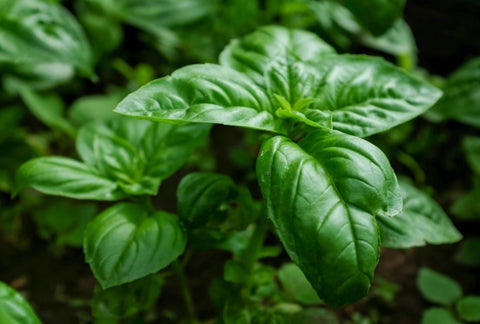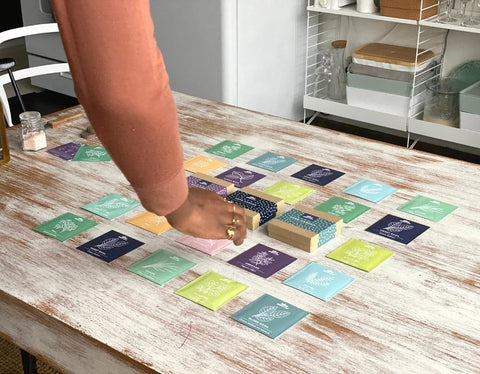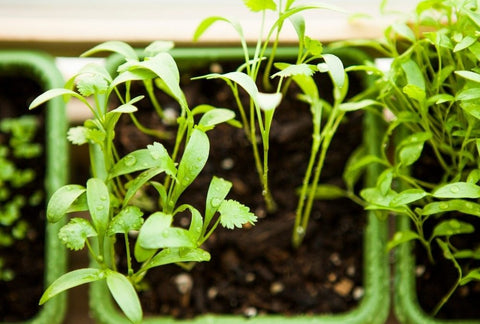Freshly picked basil smells amazing and tastes even better. It’s one of the easiest herbs to grow and has a great variety of types. In this blog, we’ll be talking about everything related to growing basil indoors, from basic facts, supplies, setup, and steps to grow, care for and harvest it.
|
Plant type |
Annual |
|
Family |
Lamiaceae |
|
Binomial name |
Ocimum basilicum |

Timing
Basil sprouts in 1-2 weeks. They can be harvested from Month 2+ on.

Full sun
Basil needs an equivalent of 6+ hours of direct sun [DLI of 18+ mol/m²/day].

Care
Herbs such as basil are very beginner-friendly. You’ll sprout, thin, prune, and harvest.
TABLE OF CONTENTS
Ways to Grow Basil | Care and Maintenance for Basil | Timeline & Steps | Cultivars/Varieties
Ways to Grow Basil Indoors
Growing Basil Indoors Using Soil vs Hydroponics vs Microgreens
Grow Basil Indoors Using Soil
Basil plants do well in moist soil conditions. If the soil dries out completely the roots will die back and it will be tough for the plant to recover. On the other hand, if the roots are exposed to standing water for too long, they can rot.
Grow Basil Indoors Using Hydroponics
Of all the culinary herbs, basil is one of the options that does best in a hydroponic environment. This is due to the fact that it loves moist conditions. You can grow basil indoors using pretty much any hydroponic setup, including a basic Kratky arrangement (like our Bottle Garden Kits) or more complicated NFT, ebb & flow or aeroponics setups.
Equipment Needed for Growing Basil Indoors Using Soil
We prefer a Ceramic Self Watering Planter filled with a standard potting mix that self-regulates to keep the soil at consistent moisture for your plant to thrive (and no watering guesswork for you).
To set one up:

- Fill up the planter with dry soil from the bag, gently tamping down the top.
- Dump the soil into a large mixing bowl and add water until the soil is moist, but not sopping wet (about ½ Cup)
- Mix in 1 tablespoon of the Balanced Blend Plant Food.
Of course, basil will also grow perfectly well in a pot and soil. If you are using a regular pot, look for something at least 4” with good drainage. Remember that you are likely to need to water it every 2-3 days. . Let the top of the soil dry out between watering.
Here is another self-watering planter that we recommend:
|
|
Equipment Needed for Growing Basil Indoors Using Hydroponics
Personally, we’ve not found that the incremental performance of a sophisticated hydroponics setup is worth the extra cost and complexity. Therefore, our recommendations for growing basil hydroponically indoors are either:
- A simple Kratky setup, such as in a mason jar or bottle garden kit is great for getting started
- If you’re looking for something a bit bigger, then check out the Aerogarden range. These countertop units are relatively affordable and use basic aeroponic technology. If you do go this route, be sure to check out the replacement part options we offer.
Growing Basil Indoors as Microgreens
Basil can definitely be grown as microgreens. In fact, most herbs can be grown as microgreens. In addition to the much shorter time to harvest (in days, not months), they are also more tender, making them better garnishes for desserts and cocktails.
Click here to learn more about the different types of microgreens (herbs being one of them), or grab a copy of our eBook to learn more about all the different ways you can grow basil (and more!) at home.
Care and Maintenance of Basil Indoors
Lighting for Growing Basil Indoors
While you should take advantage of the sun (it’s free and perfect for plants) there are limited circumstances where indoor natural light is enough for Basil plants to grow well. If you’re lucky enough to get 6+ hrs of direct (unobstructed) light a day then you should be ok with sunlight, but if you have any less than this you are going to need a grow light to grow basil indoors.
For an introduction to grow lights, head over to our post on grow lights for indoor gardeners. We’ve also got a buying guide for screw in types, but to keep things simple in this guide, we’ll just provide directions for the 24W Screw in Bulb by Sansi, which we think is a good middle-of-the-road option.

If you are looking for a higher-end option - we love the Aspect Light by Soltech. For a more affordable option, a DIY setup using a 24W Screw-in Bulb by Sansi with a Clamp Light and Mechanical Timer works well too. Check out our complete guide on a DIY setup for less than $40 or our buying guide for screw-in bulbs.
How bright should your grow light be?
Basil plants need the equivalent of 6+ hours of direct sunlight [DLI of 18+ mol/m²/day] to grow their best. In order to provide an equivalent amount with a grow light, it needs to be pretty bright! Grow light placement will vary based on the wattage of the globe you’re using, but we have some guides in this blog.
How many hours per day do your Basil plants need under a grow light?
Basil plants are known as “long-day”. When they sense over 12 hours of light per day, they’ll start the end of their lifecycle and work on making seeds. We want to keep them in an earlier stage so we can keep harvesting the leaves, so we recommend setting up a timer to leave it on for only 10 hours per day.
Temperature Needed by Your Indoor Basil
Basil Plants Grow Faster in Warmer Temps
Basil plants are called “warm-weather crops” and will speed up their metabolism when temperatures are warmer. On the other hand, if things get too hot they’ll wilt and become prone to disease. Ideal temperatures are around 80°F but anything between 50 and 90°F grows well.
Water and Humidity
Herbs such as basil thrive on consistent moisture but can suffer if they’re waterlogged, so make sure to water them regularly especially if you’re using soil. To avoid your basil being waterlogged, make sure to use a pot with drainage, or just use self-watering pots, as mentioned above.
Nutrients and Fertilizers
Basil likes to start with nutrients that are equal parts nitrogen, phosphorus, and potassium (with NPK numbers like 10-10-10). For this Balanced Blend, we recommend: Dr Earth All Purpose.
Once they are growing, it’s better to use plant food that is high in nitrogen (with NPK numbers like 10-5-5). For this Herb Blend, we recommend: Joyful Dirt All Purpose
Moving Your Basil Plant Outdoors
Basil mostly thrives in warm temperatures, as we talked about before. So we suggest moving your basil plant outdoors only when the temperature is warm enough. To learn more about how to grow your basil outdoors, check this out.
Timeline and Steps on How to Grow Basil Indoors
Best Setup for Basil Plants
Below is the best setup (and a very easy one!) for growing your basil plants indoors. You’ll need:
Planter:
Ceramic Self Watering Planter or Hydroponic or pot that is at least 4" / 1 pint.
Soil:
Standard Potting Mix
Plant Food:
At the start: Balanced Blend. This should be equal parts nitrogen, phosphorus, and potassium (with NPK numbers like 10-10-10).
Ongoing: Herb Blend. This should be high in nitrogen (with NPK numbers like 10-5-5).
Grow Light:
A strong grow light that can give the equivalent of 6+ hours of direct sun [DLI of 18+ mol/m²/day].
Starting your Basil: Seed vs Cutting vs Nursery Plant
New Basil plants can be started from seed, propagated from an established plant, or purchased live at many garden centers. We prefer to sprout from seed or propagate from a stem cutting, as it results in plants that are adapted to your growing conditions and limit the chances that you accidentally bring home pests.)
How to Plant Basil seeds

Basil grows quickly from seed. Plant 5 sites in a 4" / 1-pint container. In larger containers, space sites 2" apart. For each site plant 2 seeds 1/4 inches deep. Keep the soil warm ( 65-85°F, ideally 70°F). Sprouts typically appear in 5 days but can be as quick as 3 days or as long as 7 days depending on your conditions.
Can you Clone Basil? How to Clone Basil from a Stem Cutting

If you’ve already got a Basil plant you love (or a friend does!) you may be wondering how to clone basil. You can clone basil with just sharp scissors and a clean glass of water.
First, cut a couple of 6” shoots of new growth (avoid anything woody). Next, remove the lower leaves, so the bottom half is just stem. Place in a glass of 3” of water, making sure the cut leaf spots are underwater. Place the glass on a bright windowsill and change the water every few days.
In a couple of weeks, roots should emerge and you can transplant them into your container. While using additional rooting hormones won't hurt, it’s not necessary with Basil plants.
- Cut 6” section of new growth
- Remove leaves halfway and place them in the water on a sunny window sill
- Wait 14 days for a few ½ inch roots to form and carefully transplant into their final container
How to Transplant Basil

Live starter plants give you a big jump start on your first harvest. When you’re in a garden center - pick the bushiest plant available (tall and lanky ones will be weak growers) and give it a good inspection for pests.
Leaves should be dark green without holes, spots, or curled edges. A best practice is to actually “quarantine” your plant for about a week after bringing it home to make sure it's free and clear of ride-on pests.
Ensuring it’s pest and disease-free it’s time to transplant your seedling into its final home.
- Remove some soil from its final planter - leaving enough space for the bottom of the seedling to be just higher than the soil surface.
- Hold on to the base of the stem with one hand, and turn the pot over while gently pulling the seedling. Giving the pot a few squeezes can help dislodge it.
- Place in its final container and fill around it with soil so that it’s tight, but not compacted.
Week 1-2: Check for Sprouts
You could see seedlings in as little as 3 days (though 5 days is more typical). If it’s been 7 days and you still don’t have any sprouts, it’s likely that your setup is too cold.
Week 2: Thin Your Seedlings

Thin your planter to only have 1 seedling per site - leaving the largest plant. If you are using the recommended planter (at least 4" / 1 pint) this will mean you’ve got 5 plants after thinning. By getting rid of the smaller seedlings, you’re allowing the biggest and strongest one to flourish by reducing its competition for water, food, and space.
If your seedlings are under 1 inch, stretching out, or folding over, it’s likely that they don't have quite enough light.
Week 4: How to Prune Basil Plants

Once your Basil plant has 3 sets of mature leaves you’re ready for your prune. Cut off the top set of mature leaves, leaving the bottom two (it’s best to cut right above the pair of leaves you’re keeping on the plant).
Once these branches grow out (and each has a few sets of their own leaves) you can cut the tip – just as you did with the main stem. At this point your plant will be fairly well shaped, so hone your inner Bonzi master and use your thinning and heading cuts to harvest and shape your herbs as you go.
Once your Basil plant has 3 sets of mature leaves you’re ready for your prune. Cut off the top set of mature leaves, leaving the bottom two (it’s best to cut right above the pair of leaves you’re keeping on the plant). Once these branches grow out (and each has a few sets of their own leaves) you can cut the tip - just as you did with the main stem. At this point your plant will be fairly well shaped, so hone your inner Bonzi master and use your thinning and heading cuts to harvest and shape your herbs as you go.
Month 2+: How to Harvest Basil
As your basil continues to grow, keep harvesting to encourage growth. If you only want a couple of leaves, pick leaves where new ones are emerging at the base. For a bigger harvest, cut one of the stems directly harvest, cut off the stems directly. You shouldn't harvest more than 1⁄3 of the plant at a time.
How to Use Your Freshly-harvested Basil in Cooking
As we all know, basil is a staple herb used by the most prominent chefs around the world to ordinary food lovers at home. Basil can be used in many ways:
- Toppings or combined with pasta
- Snacks or appetizers
- Toppings for soups, sandwiches, or any other dish you can think of
Check out some more of our favorite basil recipes here.
How to Preserve Basil
There are several ways to preserve or keep your herbs fresh, and here are just some of the easiest and the ones we recommend the most:
- Lazy person technique. It involves keeping the fresh herbs in their original packaging and simply storing them in the fridge.
- Storing the herbs in a glass of water inside the fridge. You can do this by cutting the end of the stem of your herb, filling a glass jar or cup with water, and placing your herb inside. Almost like a vase or bouquet of herbs!
- Keep in a glass of water under natural lighting.
- Wrap loosely in a damp paper towel.
- Freeze them herbs! Yes, you can freeze fresh herbs such as basil to use at a later time! All you need are some ice cube trays and a freezer, and you’re all set.
Month 6+: End of Life
Once your basil plant is mature, it’ll decide that it’s time to make seeds & die off. Delay this by clipping flower stalks as soon as you see them. It’s best to catch them as early as possible.
If you’d like to learn about the dozens of other herbs, fruits, and vegetables that you can grow indoors then grab a copy of our free eBook below.
Best Basil varieties to grow inside
There are over 160 types of basil – each with its unique aroma and size. Flavors range from clove to cinnamon to lemon and lime. All basil is fairly well suited to indoor growing – but specialty seed with compact statures and disease resistance will make sure you make the most out of your space.
Sweet Basil
Sweet basil has a predominantly sweet taste with anise and clove undertones and a fresh, fragrant, and slightly peppery aroma
Urban LeafGardeners' Basics Basil Seed Collection
Can’t decide? We recommend this selection of different basil seeds, including Thai, Lemon, Cinnamon, Sweet and Dark Opal Basil Seeds from Gardeners' Basics.
AmazonWe hope that this blog has given you everything you need to know about growing basil indoors. In case you have any questions, just leave a comment below.












There are no comments for this article. Be the first one to leave a message!